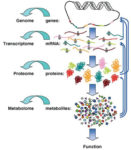A 15-year collaboration with the Functional Genomics Center Zurich has helped the Neuroepigenetics lab of Prof. Isabelle Mansuy advance their research on memory and epigenetic inheritance. Prof. Mansuy explains how the FGCZ has contributed to their success.

One of the great assets of the Functional Genomics Center Zurich is to provide methodologies and technologies for every existing omics, ranging from classical genomics to proteomics and metabolomics. The power of such multi-level analyses makes to possible to integrate data and relate DNA features to RNA, proteins and metabolites which helps better understand regulatory pathways and opens many mechanistic perspectives.
Novel methods for synaptosomal fractions
Prof. Mansuy’s Neuroepigenetics laboratory at the Brain Research Institute has been a long-standing collaborator of the FGCZ and user of the facilities since the FGCZ established itself as a UZH/ETHZ platform in 2002. Through its initial research on memory and more recently on epigenetic inheritance, it has used all levels of analyses provided by FGCZ, most often as collaborative work but also as a service. Together with researchers, technicians and bioinformaticians in the center, it has developed novel methods for the analyses of the whole proteome in synaptosomal fractions, of phosphoproteins in the brain, and of posttranslational modifications in the brain and germ cells.
Study of exposure to trauma
Recently, Prof. Mansuy’s lab has exploited the FGCZ RNA sequencing and epigenomic platforms for the identification of small and long non-coding RNAs, and the DNA methylome in biological samples as diverse as blood, sperm, spermatogonia and brain from mouse pups or adults. The purpose of these analyses is to assess the consequences of exposure to postnatal trauma on the transcriptome and epigenome in adulthood and across generations and gain molecular insight into the mechanisms of transgenerational epigenetic inheritance. It has also used the metabolomic platform to conduct unbiased analyses of metabolites in the blood of traumatized mice during development and in adulthood. These analyses revealed some of the components in circulation that can link the brain to germ cells and other tissues, and transfer molecular signals of life experiences across the body and across generations.
Such a multi-omics facility at the door of the Brain Research Institute is a tremendous plus for brain research and for progress in molecular psychiatry.
For further reading, see e.g.
- Tweedie-Cullen, R. Y., Wollscheid, B., Livingstone-Zatchej, M. & Mansuy, I. M. Neuroproteomics and the detection of regulatory phosphosites. Curr. Proteomics 4, (2007). PubMed Abstract
- Brunner, A. M., Nanni, P. & Mansuy, I. M. Epigenetic marking of sperm by post-translational modification of histones and protamines. Epigenetics Chromatin 7, 2 (2014). Article
- Park, C. S., Rehrauer, H. & Mansuy, I. M. Genome-wide analysis of H4K5 acetylation associated with fear memory in mice. BMC Genomics 14, 539 (2013). Article